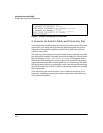
6-4
Configuring Secure Shell (SSH)
Terminology
Terminology
■ SSH Server: A ProCurve switch with SSH enabled.
■ Key Pair: A pair of keys generated by the switch or an SSH client
application. Each pair includes a public key, that can be read by
anyone and a private key, that is held internally in the switch or by a
client.
■ PEM (Privacy Enhanced Mode): Refers to an ASCII-formatted
client public-key that has been encoded for portability and efficiency.
SSHv2 client public-keys are typically stored in the PEM format. See
figures 6-3 and 6-4 for examples of PEM-encoded ASCII and non-
encoded ASCII keys.
■ Private Key: An internally generated key used in the authentication
process. A private key generated by the switch is not accessible for
viewing or copying. A private key generated by an SSH client applica-
tion is typically stored in a file on the client device and, together with
its public key counterpart, can be copied and stored on multiple
devices.
■ Public Key: An internally generated counterpart to a private key. A
device’s public key is used to authenticate the device to other devices.
■ Enable Level: Manager privileges on the switch.
■ Login Level: Operator privileges on the switch.
■ Local password or username: A Manager-level or Operator-level
password configured in the switch.
■ SSH Enabled: (1) A public/private key pair has been generated on
the switch (crypto key generate ssh [rsa]) and (2) SSH is enabled (ip
ssh). (You can generate a key pair without enabling SSH, but you
cannot enable SSH without first generating a key pair. See “2.
Generate the Switch’s Public and Private Key Pair” on page 6-10 and
“4. Enable SSH on the Switch and Anticipate SSH Client Contact
Behavior” on page 6-15.)


















